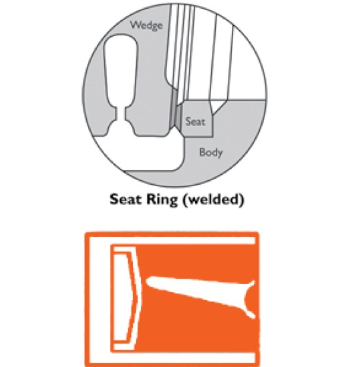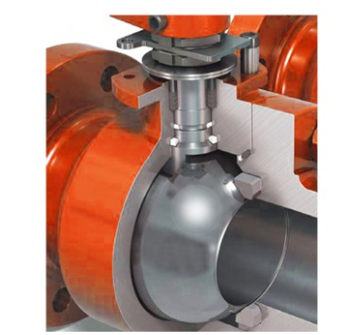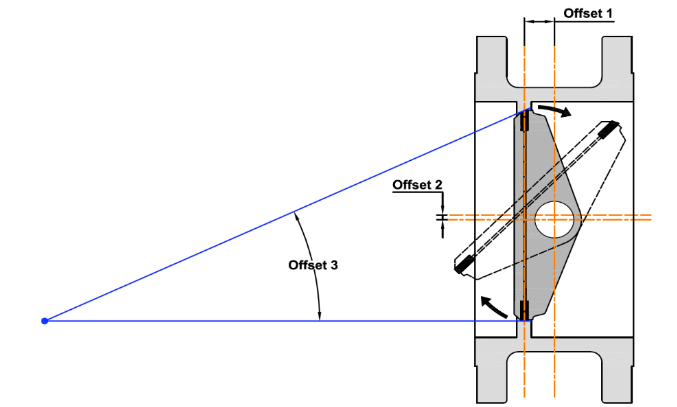Selecting the proper valve seat is crucial for maintaining valve integrity and functionality in different industrial applications. This article reviews valve seat types, key considerations when choosing seat material, and a typical selection chart to guide decision-making.
What is a Valve Seat?
A valve seat is a critical component of a valve that could either be part of the valve body or an insert within the valve body. It provides a sealing surface for the valve disc to close against, thus helping to regulate or stop fluid flow. The type of valve seat in use and its material greatly influence the seal’s performance and durability.
Types of Valve Seat
The seating mechanism of a valve influences its ability to satisfy sealing requirements and serves as a guide in the seat material selection process. The industry has a variety of mechanisms, and the following sections highlight a few of them.
Self-energized Seating
This type of mechanism seals the valve independent of line pressure, which provides leak-free sealing at low pressures. It can achieve this using springs or other mechanical systems that continuously load the disc. In addition, this seating system can accommodate thermal expansion better than most other systems without jamming. These features typically make the valve capable of bidirectional flow, double block, and bleed. Examples include trunnion-mounted ball valves, API 6D parallel slide gate valves, and soft-seated expanding plug valves.
Friction or Interference Fit
Like self-energized seating, this type also seals independently of line pressure, providing bi-directional flow, double block, and bleed capabilities. Its sealing mechanism creates a wedging or squeezing action between the disc and seat, thus creating a seal. Examples include wedge gate valves, butterfly valves (eccentric or center-lined), and resilient seated valves like Teflon-lined plug valves.

Pressure Assigned Seating
This type of seating uses pressure to assist valve sealing by pushing the disc onto the downstream seat. As a result, higher pressure improves the seal within the capabilities of the seat material and tolerances. Hence, this seating type is not suitable for double block and bleed applications as it has only one seat sealing. Another disadvantage is that it is not leak-tight at very low pressure or under vacuum, but it can be bidirectional, like a floating ball valve, as it has upstream and downstream seats.

Positioning Seating
Positioning seating achieves an effective seal by placing the valve disc in a fairly acute position. As a result, it deploys measures like gearbox stops to avoid over closing and keeps the valve in the optimum sealing position. This style of valve requires no line pressure to seal it and has minimal interference during opening and closing. An example is the double-offset butterfly valve.

A variation of the positioning seating valve is the torque seating valve, which requires a certain amount of torque to affect a seal. This is because it often serves for higher pressures and metal-to-metal minimal friction fit applications that need a tight shut-off. A typical example of this is the triple-offset butterfly valve.
Valve Seat Material Selection
Selecting the right valve seat material ensures optimal valve performance, durability, and safety. Several factors guide this process, and the following sections highlight a few of them.
Type of Fluid
The seat material must be compatible with the process fluid to ensure it is not chemically attacked. This is why PTFE is a common seat material, as it is compatible with a wide range of process fluids. Fluids containing abrasive materials require harder seat materials like tungsten carbide or stainless steel.
Operating Temperature and Pressure
The seat material must be able to withstand the process temperature and pressure without deforming or degrading. For example, many elastomeric seats are not suitable for high-temperature applications. The seat material should also be able to endure thermal and pressure cycling, which causes expansion and contraction, and still maintain a tight seal.
Mechanical Wear and Tear
Valves that are frequently operated are at risk of quickly wearing down, especially if the sealing mechanism requires interference. Ideal materials for such applications include stainless steel-filled PTFE and glass-filled PTFE.
Sealing Requirements
The allowable leakage rate is key in determining the valve seat material. Generally, valves requiring bubble-tight shutoff use soft seats such as PTFE and NBR. Applications where minor leakage is acceptable can use metal seats.
Regulatory and Safety Standards
Applications in critical industries such as nuclear and medical may have stringent safety requirements that influence material selection. Complying with standards like API, ISO, and ANSI can also dictate material choices.
Valve Seat Material Chart
A valve seat material chart is an essential tool in the valve selection process. It provides crucial information about the properties and performance characteristics of different valve seat materials, thus serving as a guide to professionals.
| Material | Temperature Range(℃) | Pressure Rating(psi) | Chemical Compatibility | Water Resistance | Common Applications |
| PTFE (Teflon) | -200 to 260 | 3,000 | Excellent, as it is compatible with a wide range of fluids. | Moderate | Chemical processing, food, and pharma. |
| EPDM | -40 to 120 | 1,500 | Good, especially with water, steam, and alcohol. | Moderate | Water treatment and HVAC. |
| NBR | -40 to 120 | 3,000 | Good compatibility with oils and fuels. | Good | Abrasive fluids and other high-wear environments. |
| Viton | -20 to 200 | 2,000 | Excellent with chemicals and oils. | Good | Chemical processing and fuel systems. |
| Stainless Steel | -270 to 870 | 5,000 | Compatible with a wide range of process fluids. | Excellent | High-temperature, as well as high-pressure applications. |
| Tungsten Carbide | -50 to 1,000 | 10,000 | Excellent, especially with abrasive fluids. | Excellent | Abrasive fluids and other high wear environments. |

Recent Comments